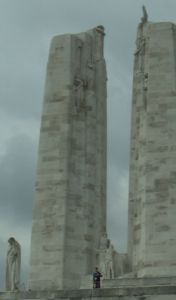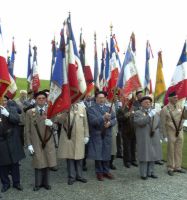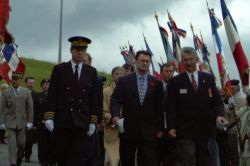Direct from Vimy, France - May 25
Archived Content
Archived information is provided for reference, research or recordkeeping purposes. It is not subject to the Government of Canada Web Standards and has not been altered or updated since it was archived. Please contact us to request a format other than those available.
May 25, 2000
Raise your flasks
Hold your guns high...

Pipe Major John Macdonald
The morning's ride to Vimy Ridge began with the now usual round of camaraderie. The group of delegates has only been together for four days, but that has been long enough for them to establish a pleasant familiarity. A little way into the trip, the Honourable Elsie Wayne asks for our attention while she plays us a recording by the Canadian band, Tanglefoot. The lyrics are compelling, as the strong voices recount the story of three young Canadian boys who set out to war in 1914, one from Winnipeg, one from Kenora and one from Montreal. They make a pact to return home and meet up again, but this is not to be, as we find out from the old man, now in an institution over 80 years later.
The mood on the coach shifts almost immediately as we grasp that today is the beginning of the journey home for one such young man...
We arrive at Vimy Ridge. Wind whips our coats and jackets around, as we make our way along the gravel road to the front of the Vimy monument to take part in the ceremony to hand over the remains of the unidentified soldier. The clouds racing across the sky are threatening to soak us with a repeat of the morning's earlier downpour. French and Canadian troops are formed up on parade. The local Colour Party's flags wave us a welcome. The monument is beautiful. The mournful figures draped in limestone folds who grace it are symbolic of our country and its youth, who went to war.

Distinguished Vimy locals in the Colour Party
The distinguished official witnesses walk with a quicker step as they are directed to a white tent -- shelter from the piercing chill. Once seated inside, First and Second World War veterans, Paul Métivier and Ernest Smith, V.C., chat easily with the Korea witness, Gordon Strathy and Sgt. Réjeanne Bélanger, who is present on behalf of Canadian peacekeepers. The representatives of Canadian veterans' organizations stand tall as they wait for the ceremony to begin. For them, this day has been a long time coming. Under the Royal Canadian Legion's leadership, the group's planning and preparation have brought them to this proud moment, one which marks Canada's entry into the new millennium. They have worked through many challenges, in cooperation with the Canadian government and the military to ensure that their commemorative undertaking is a success.
Watching the youth witnesses, two Canadians and two French, it is hard to get a fix on what this historic moment might mean for them. The four of them characteristic eighteen-year-olds, they are, at once, confident and awkward. Their demeanour shifts, as one minute they are primed and taking everything in and, the next, they are lost in thought.

Canadian and French youth witnesses
The procession begins,led by Veterans Affairs Minister, the Honourable George Baker, and the Prefect for Pas-de-Calais, M. Dussourd. The group moves through the alley of French Colours to a dais opposite the catafalque. The crowd's attention focuses to the far side of the concourse, when the hearse drives into sight. Slowly it rounds the curve and slips across our plane of view, coming to a stop about 200 metres down the slope to our left. After rousing versions of the French, British and Canadian National anthems played by the French military band, the General Salute is received and the coffin is removed from the hearse.

Prefect of Pas-de-Calais, M. Dussourd and Minister Baker arrive with National Vimy Memorial Director, Jacques Morel
Steadily, the eight French pallbearers raise the flag-draped casket to their shoulders and press their faces into the weight of its silver maple. They march up the hill, flanked by honourary pallbearers from France and representatives of all other Commonwealth countries.
When the Prefect of Pas-de-Calais speaks, he salutes Canadians for the bravery they have demonstrated in their European triumphs and defeats, over the course of Canada's brief military history -- the Somme, Ypres, Vimy Dieppe, Caen and Falaise.
"The traces of your struggle are very much present in our land. We face the Vimy Monument on which are engraved the names of 11,285 soldiers who were pronounced 'missing in action and presumed dead'. It is a testament to 'Canada who mourns her dead ... In recalling your sacrifices you also commemorate the valour and strength of character which you have shown when honour and peace needed to be defended'".

French veteran returns from paying his respects
In his remarks, the Vice-President of the Commonwealth War Graves Commission, Admiral Sir John Kerr, also tells us of the wartime ties between Canada and France. Of Canada's 110,000 First and Second World War dead, about 48,000 are commemorated in France, with the heaviest concentration of graves and memorials being in the north of the country. Together, the French and the Commission work closely to maintain beautiful and serene resting places for these soldiers.
Minister Baker, in his remarks, explains the historic significance of repatriating the remains of one of those who died in this part of France.

Leaving France
"...it is more than fitting that his remains come from the vicinity of Vimy Ridge, where Canadians fought as a combined force for the first time, and where, many historians agree, Canada came of age. The ramifications for Canada's growing stature were not long in coming. When peace came, Canada had its own seat at the peace table, and signed the Treaty of Versailles as a separate nation."
Within the next few days, Canada will have its own memorial to the Unknown Soldier. A visible testament to so many, who answered their country's call -- those who returned home and those stayed behind, having been laid to rest where they fell. It will remind us of the valour of the Canadian men and women who, today and in the years to come, will place themselves at risk in the cause of peace and freedom.
Ottawa, Canada
- May 28, 2000 - The Funeral Procession and Service of Recommittal
- May 27, 2000 - Canadian War Museum, Reception & Video Screening
- May 26, 2000 - Visitation
- May 25, 2000 - Arrival at Peace Tower
Vimy, France
- Date modified: